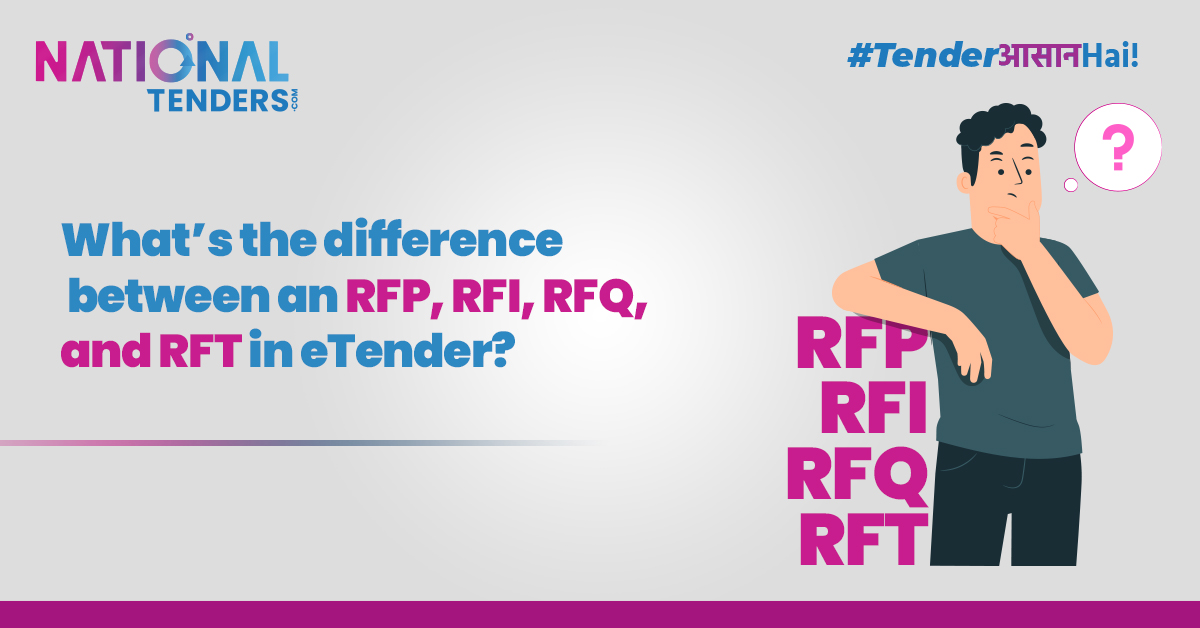- Home
- >
- Blog
OUR BLOG
A collection of stories about our people, our capabilities, our research, and the ever-changing face of our firm.

NationalTenders
What’s the difference between an RFP, RFI, RFQ, and RFT in eTender? | 26 Aug, 2023
What’s the difference between an RFP, RFI, RFQ, and RFT in eTender?
Some of the most often used words in eTendering are RFI, RFT, RFQ, and RFP. What do they, however, actually mean? The meanings of RFI, RFP, RFT, and RFQ are they the same or different? When it comes to sourcing and procurement in the public and private sectors, these are phrases that indicate the kind of request the tendering authority/company is making. Let's examine how each of these phrases functions individually, how they are similar or different from one another, and how and when they are used in tender contracts.
What is the full form of RFP, RFQ, RFI, and RFT?
In the realm of government tender, there exist several significant terms that are commonly used and can often cause confusion for even experienced bidders. One such instance is the distinction between Request for Proposal (RFP), Request for Quotation (RFQ), Request for Information (RFI), and Request for Tender (RFT) in the context of eProcurement.
In the context of eProcurement, there are several distinct types of requests that are commonly used. These include Request for Proposal (RFP), Request for Quotation (RFQ), Request for Information (RFI), and Request for Tender (RFT). Each of these requests serve different purposes in the procurement process. For example, an RFP is used to solicit detailed proposals from vendors, while an RFQ is used to request quotes for specific products or services. An RFI is used to gather information for potential vendors, and an RFT is used to solicit formal bids with detailed tender documents and tender details. With the rise of online tender submission, these requests can now be easily managed and responded to in a more efficient manner. Understanding these terminologies is vital for any bidder in the government contract domain to effectively navigate the world of eProcurement.
Difference between RFP, RFQ, RFI & RFT
This section provides clarification on the importance of frequently utilized terms in procurement, such as RFI, RFT, RFP, and RFQ. These terms are crucial for understanding the tender details and processes involved in the procurement process. By defining these commonly used terms, individuals can better navigate the procurement arena and successfully participate in tender opportunities.
These terms are employed in the context of inviting potential suppliers to submit their proposals for the procurement of goods or services. An invitation is extended to suppliers to provide information, pricing, and any other pertinent details regarding their offerings. RFI ascertains the capability and suitability of suppliers, while RFT is used to procure commodities through a formal tender process. RFP pertains to proposals for complex projects, and RFQ is employed to procure standard and readily available products. Familiarity with the parameters of these terms is crucial for organizations involved in procurement practices.
What is an RFT?
A Request for Tender is a formal document that an organization uses to invite potential service providers to submit a proposal or bid for a specific project or contract. It is typically used in the procurement process to streamline the selection of a service provider. The request for tender outlines the requirements and specifications of the project, along with any terms and conditions that must be met by the service provider. It provides detailed information on the project objectives, scope, timeframes, and evaluation criteria.
An RFT is often issued through an online portal or platform, where interested service providers can access the document and submit their proposals electronically. The organization may also require the service providers to upload certain supporting documents, such as company profiles, certifications, and financial statements. These documents enable the organization to evaluate the capability and suitability of the service providers.
The RFT is usually provided in a PDF format, ensuring that the document remains secure and uneditable. By issuing a request for tender, an organization can attract a competitive pool of service providers and ensure a fair and transparent selection process. It allows the organization to assess the proposals based on objective criteria and select the most suitable service provider to fulfill their specific requirements.
What is an RFP?
A Request for Proposal is a term used to describe a formal document that outlines the specific requirements and desired outcomes for a certain project or task. It is a type of request made by a company or organization to potential bidders in order to find the most suitable vendor or supplier.
The RFP commonly includes a detailed description of the project, as well as the expected deliverables, timeline, and any specific qualifications or criteria that bidders must meet. This structured approach allows companies to clearly communicate what they are looking for and helps ensure that potential bidders understand the expectations and can provide proposals that are tailored to meet the company's needs. By issuing an RFP, a company wants to attract the attention of qualified and experienced potential bidders who can offer the best solutions.
The potential bidders receive the RFP and are given a bid validity period to review the document and submit their proposals. This enables companies to evaluate various proposals, compare them against each other, and select the most favorable bid that meets their requirements and objectives.
What is a Request For Quote?
A Request for Quote is a formal document sent by a buyer to potential suppliers, inviting them to submit a quote to supply goods or services. RFQs are commonly used in the public sector, where transparency and accountability are highly sought after.
The purpose of an RFQ is to seek the best value for the buyer, ensuring that the goods or services provided are not only of high quality but also cost-effective. In order to ensure fair competition, the RFQ must outline the terms and conditions, including the specifications of the desired goods or services, delivery requirements, and any other pertinent information. Potential suppliers are expected to respond with detailed quotes, providing prices, proposed timelines, and any additional relevant information that they believe will help them secure the bid. When evaluating the responses, the buyer considers factors such as price, quality, past performance, and the supplier's ability to deliver on time. Competency in meeting the buyer's requirements is a critical aspect that is taken into consideration.
Once all quotes have been received, the buyer may decide to shortlist a few suppliers for further negotiations or proceed with awarding the contract to the supplier who has submitted the most suitable tender request. Overall, the RFQ process ensures a fair and transparent procurement process in the public sector, allowing for the selection of the most competent and qualified suppliers who offer the best value for the buyer.
Example of RFI vs RFP vs RFT vs RFQ
RFI, RFP, RFT, and RFQ are all documents used in procurement processes to gather information and solicit bids from potential suppliers or service providers. Each of these documents has a specific purpose and is used at different stages of the procurement process.
An RFI is typically used at the initial stage of the process when an organization is seeking general information about products, services, or potential suppliers. It does not require pricing or detailed proposals but aims to gather information to solve a particular problem or meet a specific need. For example, a company that wants to implement a new software system may want to issue an RFI to understand the available options and capabilities of different software vendors.
On the other hand, an RFP is a formal request for suppliers or service providers to submit detailed proposals that include pricing, technical specifications, and other relevant information. It is used when the organization has defined its requirements more precisely and is looking for a solution. In this case, the organization may want to leverage the expertise of suppliers to solve a specific problem or meet a particular need.
Similarly, an RFT is commonly used in public procurement processes, especially in government contracts. It is a formal request for qualified suppliers to submit tenders for a project or contract. The RFT outlines the requirements, evaluation criteria, and terms and conditions for the project. The organization executing the project often does an evaluation of the tenders received before selecting a supplier.
Finally, an RFQ is a document used to collect quotations or price proposals for particular goods or services. It is typically used when the organization has clearly defined requirements and specifications and is looking to select a supplier based on pricing. An RFQ is widely used in situations where the organization may want to compare multiple suppliers and select the most cost-effective option.
 Top 5 Government Sectors in India with Growing Tender Opportunities in 2024
Top 5 Government Sectors in India with Growing Tender Opportunities in 2024 Top 5 States in India with Highest Government Tenders in 2024
Top 5 States in India with Highest Government Tenders in 2024 India @ 2030: India's Business Landscape in the Next 5 Years
India @ 2030: India's Business Landscape in the Next 5 Years International Business Opportunities V/S Business Opportunities in India (Guide)
International Business Opportunities V/S Business Opportunities in India (Guide) How Did Government e-Marketplace (GeM) Change Indian Procurement?
How Did Government e-Marketplace (GeM) Change Indian Procurement?